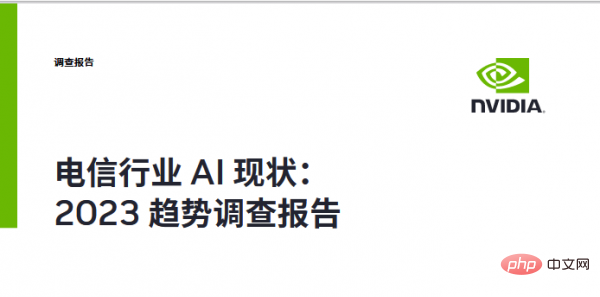Home >Technology peripherals >AI >Unstoppable trend: The telecommunications industry faces AI opportunities and challenges
Unstoppable trend: The telecommunications industry faces AI opportunities and challenges
- PHPzforward
- 2023-05-07 10:46:091006browse

Artificial intelligence (AI) is widely recognized as a key component of digital transformation, and deployment of AI is driven in large part by the complexity of 5G and related services. The ubiquitous nature of the cloud and its more affordable computing resources have spurred the adoption of AI by telecoms and other companies.
Recently, NVIDIA surveyed more than 400 telecom industry professionals around the world, including China, on their views on the opportunities and challenges of implementing AI-based practices within their companies and industries.

This report summarizes the key survey insights and details the definition, investment decisions and implementation methods of artificial intelligence in the telecommunications industry in 2023.
Despite the survey results showing that AI is of great concern, the telecom industry is still in the early stages of AI adoption and needs support to achieve a clear return on investment.
Opportunities and challenges of artificial intelligence in the telecommunications field
According to the survey, the telecommunications industry attaches great importance to AI, and industry stakeholders clearly show a strong interest in AI. interest.
However, in the survey, only 34% of respondents said they had been using AI for more than six months, 23% said they were still learning about different AI application scenarios, and 18% reported They are working on an AI pilot project.
For respondents who are in the trial or implementation stage, the vast majority believe that AI has already had a positive impact on revenue and costs. Some 73% of respondents reported that AI implementations resulted in revenue growth over the past year, with 17% citing more than 10% revenue growth in specific parts of the business.
Similarly, 80% of respondents reported achieving annual cost reductions in the past year after implementing AI, with 15% citing cost reductions in specific parts of their business. Reduced by more than 10%.
Influencing factors influencing telecom companies’ AI investments
Despite reports about AI’s positive impact on revenue and costs, many respondents still struggle to quantify its impact ROI on AI investments. Some 44% of respondents felt that ROI could not be adequately quantified, illustrating the gap between enterprises’ desire to introduce AI-based solutions and reality.
In an industry with billions in annual capital expenditures, the level of investment in AI appears to be low. Typically, mid- to large-sized telecom companies spend at least $1 billion annually on capital expenditures. However, 60% of respondents (2021) and 50% (2022) will spend less than $1 million on AI. At the high end, 2% of respondents will spend more than $50 million in 2021, rising to 3% in 2022.
Of all the factors driving investment in AI, the move from proof of concept and pilot phases to implementation is the most notable response. Economic uncertainty and the need to prioritize spending elsewhere also drove decisions.
Consistent with expectations for using AI to optimize operations, respondents noted that their companies are now prioritizing AI investments in network operations, customer experience optimization, and network planning.
Best Practices for Telecom Enterprises to Deploy AI
The survey shows that 54% of telecom companies are deploying AI solutions in hybrid environments because they want to enjoy the cloud Efficiency while maintaining enhanced isolation and control of the local environment.
Those concerned about information security are more likely to choose a local environment. Instead, those seeking to benefit from the breadth, availability and performance of cloud solutions are more likely to choose a cloud environment. In fact, the choice of deployment environment is a trade-off between security and performance.
As the saying goes “professional people do professional things”, when it comes to AI, telecom companies rely on their partners to provide materials, support and expertise to build infrastructure, operate or develop services for customers.
47% of respondents reported that their AI solutions are co-developed with partners, and 61% said their top priority for AI spending is “working with third-party partners to accelerate AI” use".
The partnership also creates opportunities for telecom companies to create new services for customers at lower investment costs and with the ability to scale quickly. 51% of respondents said they develop AI solutions for internal and external users.
Conclusion
The role of AI in the telecommunications industry has just begun.
AI will penetrate into all aspects of the value chain, helping to drive creative transformations in network planning and deployment, network operations, customer interactions, and new products and services.
AI will unlock opportunities and solve challenges that can impact net revenue (by improving TCO through optimizing capex and opex) and gross revenue (by creating new revenue).
The above is the detailed content of Unstoppable trend: The telecommunications industry faces AI opportunities and challenges. For more information, please follow other related articles on the PHP Chinese website!
Related articles
See more- Technology trends to watch in 2023
- How Artificial Intelligence is Bringing New Everyday Work to Data Center Teams
- Can artificial intelligence or automation solve the problem of low energy efficiency in buildings?
- OpenAI co-founder interviewed by Huang Renxun: GPT-4's reasoning capabilities have not yet reached expectations
- Microsoft's Bing surpasses Google in search traffic thanks to OpenAI technology

